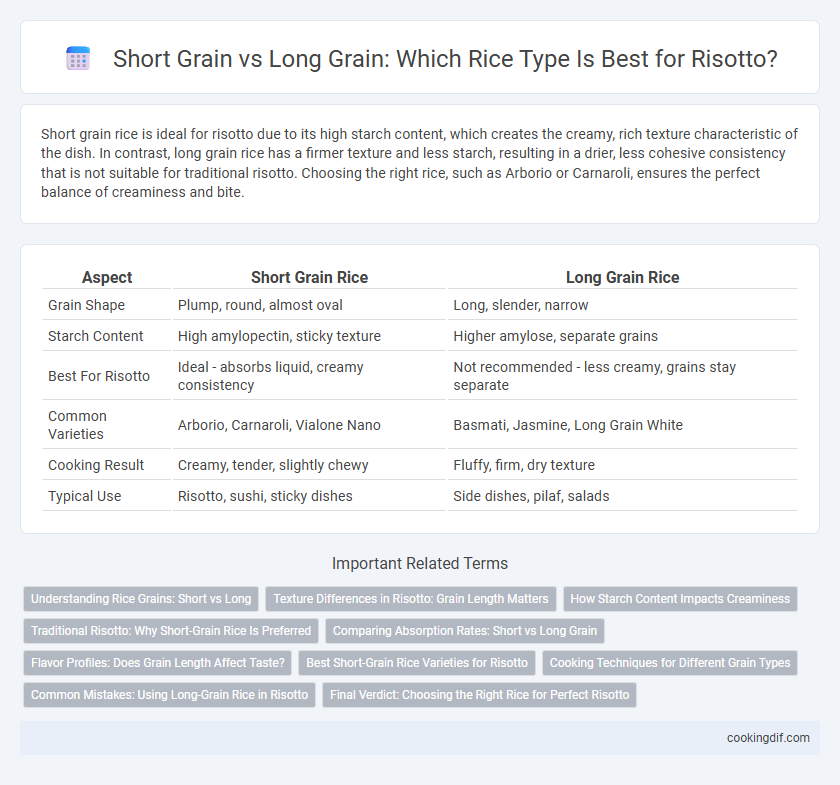Short grain rice is ideal for risotto due to its high starch content, which creates the creamy, rich texture characteristic of the dish. In contrast, long grain rice has a firmer texture and less starch, resulting in a drier, less cohesive consistency that is not suitable for traditional risotto. Choosing the right rice, such as Arborio or Carnaroli, ensures the perfect balance of creaminess and bite.
Table of Comparison
| Aspect | Short Grain Rice | Long Grain Rice |
|---|---|---|
| Grain Shape | Plump, round, almost oval | Long, slender, narrow |
| Starch Content | High amylopectin, sticky texture | Higher amylose, separate grains |
| Best For Risotto | Ideal - absorbs liquid, creamy consistency | Not recommended - less creamy, grains stay separate |
| Common Varieties | Arborio, Carnaroli, Vialone Nano | Basmati, Jasmine, Long Grain White |
| Cooking Result | Creamy, tender, slightly chewy | Fluffy, firm, dry texture |
| Typical Use | Risotto, sushi, sticky dishes | Side dishes, pilaf, salads |
Understanding Rice Grains: Short vs Long
Short grain rice, known for its high starch content and sticky texture, is ideal for creating the creamy consistency essential in risotto. Long grain rice, with its lower starch and firmer texture, tends to remain separate and less creamy, making it less suitable for traditional risotto dishes. Understanding these grain differences helps achieve the perfect balance of texture and flavor in risotto recipes.
Texture Differences in Risotto: Grain Length Matters
Short grain rice, such as Arborio, is essential for achieving the creamy and tender texture characteristic of risotto due to its high starch content and plump, rounded grains. Long grain rice varieties lack sufficient starch and tend to produce a drier, less cohesive dish with a fluffier texture that does not bind as well with the broth. Choosing short grain rice ensures optimal absorption of liquid and a rich, velvety consistency critical to authentic risotto.
How Starch Content Impacts Creaminess
Short grain rice varieties like Arborio and Carnaroli have a higher starch content, which is crucial for creating the creamy texture characteristic of risotto. The abundant amylopectin starch in short grain rice releases more during cooking, thickening the broth and binding the ingredients together. Long grain rice contains less starch, resulting in a drier, less cohesive dish that lacks the signature creaminess of traditional risotto.
Traditional Risotto: Why Short-Grain Rice Is Preferred
Short-grain rice varieties such as Arborio, Carnaroli, and Vialone Nano are preferred for traditional risotto due to their high starch content, which creates a creamy and velvety texture essential to the dish. Unlike long-grain rice, short-grain rice absorbs liquids more effectively and releases amylopectin, contributing to the risotto's signature consistency. This unique starch composition allows the rice to remain tender yet firm (al dente) while developing its rich, luscious mouthfeel.
Comparing Absorption Rates: Short vs Long Grain
Short grain rice exhibits a higher absorption rate compared to long grain rice, making it ideal for risotto as it absorbs more liquid and releases starch, creating a creamy texture. Long grain rice absorbs less liquid and retains a firmer, less sticky consistency, which is less suited for the traditional creamy risotto. The superior starch content in short grain varieties like Arborio or Carnaroli enhances the dish's characteristic smoothness and richness.
Flavor Profiles: Does Grain Length Affect Taste?
Short grain rice varieties, such as Arborio and Carnaroli, are favored for risotto due to their high amylopectin content, which creates a creamy texture and releases a rich, slightly nutty flavor during cooking. Long grain rice, like Basmati or Jasmine, contains less starch, resulting in grains that remain separate and impart a more delicate, floral aroma but lack the creamy consistency essential to traditional risotto. Grain length significantly affects the flavor profile by influencing starch release and texture, which are critical to achieving the characteristic taste and mouthfeel of authentic risotto dishes.
Best Short-Grain Rice Varieties for Risotto
Short-grain rice varieties are ideal for risotto due to their high starch content, which creates the dish's characteristic creamy texture. The best short-grain rice varieties for risotto include Arborio, Carnaroli, and Vialone Nano, each known for their ability to absorb liquid while maintaining a firm texture. Carnaroli is often regarded as the premium choice for risotto because of its superior creaminess and resistance to overcooking compared to Arborio and Vialone Nano.
Cooking Techniques for Different Grain Types
Short grain rice, particularly Arborio, is preferred for risotto due to its high starch content, which creates a creamy texture during slow, gradual cooking with constant stirring. Long grain rice, such as basmati, remains separate and fluffy because it has less starch and requires different cooking methods like boiling or steaming to prevent sticking. Adapting techniques to rice type, such as controlling liquid absorption and stirring frequency, is essential to achieve the desired consistency in risotto dishes.
Common Mistakes: Using Long-Grain Rice in Risotto
Using long-grain rice in risotto results in a dry, non-creamy texture because it lacks the high starch content necessary for the dish's signature creaminess. Short-grain varieties like Arborio or Carnaroli release more amylopectin, which thickens the liquid and creates the risotto's velvety consistency. Substituting with long-grain rice compromises the absorption of broth and flavor, leading to a less authentic and less satisfying risotto experience.
Final Verdict: Choosing the Right Rice for Perfect Risotto
Short grain rice varieties like Arborio and Carnaroli are preferred for risotto due to their high starch content, which creates the dish's signature creamy texture. Long grain rice lacks sufficient amylopectin starch, resulting in a drier, less cohesive risotto with separate grains. Choosing short grain rice ensures optimal absorption of broth and a velvety consistency, essential for authentic risotto perfection.
Short Grain vs Long Grain for rice type Infographic

 cookingdif.com
cookingdif.com